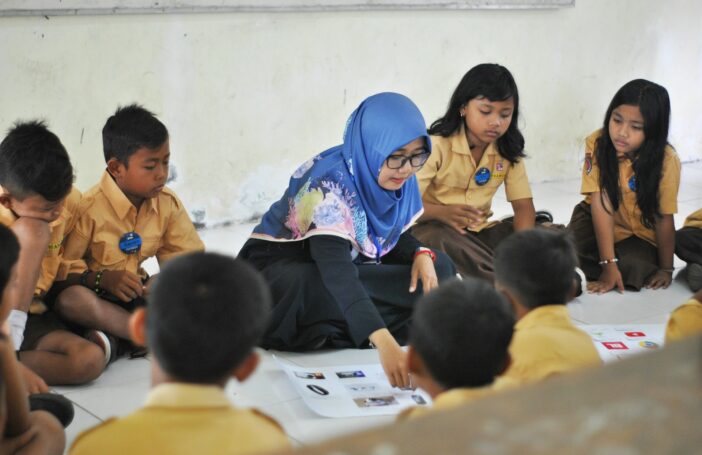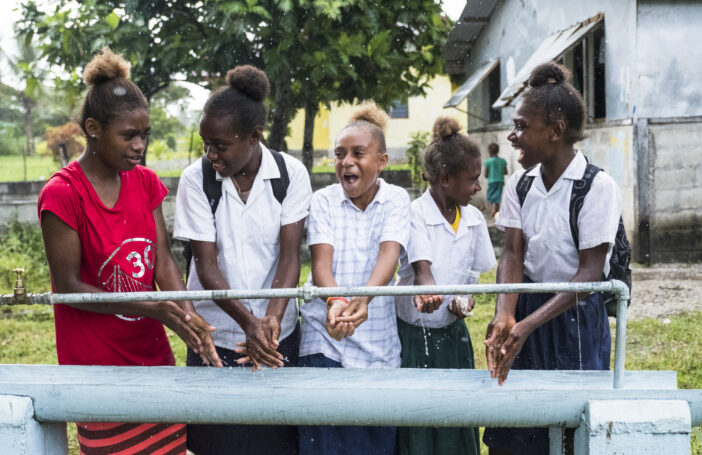This is an edited version of a keynote address delivered at the 2023 Australasian AID Conference on 5 December 2023.
Today, I’d like to reflect on why Southeast Asia stands out in the global history of gender, for pioneering female political and spiritual leadership; how job-creating economic growth, urbanisation and universities are the major contemporary drivers of gender equality; and how development cooperation can promote gender equality.
If you were to invent a time machine, where would you go to avoid gender discrimination? Pre-Christian Europe, the Middle East, North Africa, South Asia, Central Asia and East Asia were all patrilineal and patrilocal. Survival and solidarity were rooted in clans, which were governed by men. Sons were celebrated as scions of the family line; heralded as providers and protectors. Daughters were merely temporary: they married out and moved away.
Since patrilineal societies trace descent down the male line, they usually care about paternal certainty and legitimate biological heirs. Virginity, chastity and cloistering were all idealised. In Ancient Greece, women were seen as inferior and ideally secluded. In public discourse, women’s names were not uttered. Men gained honour by providing for their families and keeping their wives at home.
Conformity was imperative for trust and respectability. Since no family wanted to deviate unilaterally, jeopardise social connections and risk ostracism, all remained locked into this equilibrium, where women’s market activities were a last resort of economic desperation. Mixing and mingling with non-relatives risked rumour of impropriety and forfeited their honour. As long as market wages remained meagre, most women remained at home. Still today, the Middle East, North Africa and South Asia are caught in what I call “the Patrilineal Trap”. Female earnings are too low to compensate for men’s loss of honour.
But female seclusion was not universal! Southeast Asia, Sub-Saharan Africa and pre-conquest America were largely bilateral or matrilineal. Descent was traced down both sides of the family, or just the maternal. There was no obsession with chastity, since the family line was created by women; all their children were legitimate.
Under bilateral or matrilineal kinship, women moved more freely, built independent networks and could gain respect as rulers. Folklore was seldom male-biased and language was not gendered. Today, matrilineal communities are typically more supportive of female leaders. Since male honour is not contingent on female chastity, female employment rises rapidly in response to job-creating economic growth. When factories opened up in Cambodia and Vietnam, women hopped on their scooters and provided for their families.
Conquest and inherited wealth gave rise to patriarchy and patriliny
So what explains the global heterogeneity in kinship? Why were some groups patrilineal, while others were bilateral or matrilineal? To be perfectly honest, it’s very difficult to know why people did stuff thousands of years ago. But as I trace cultural evolution in every society, I see some systematic trends.
- When patriarchal forces conquered territories, they tended to institutionalise patriarchy.
- Societies with scarce, valuable heritable assets (land or herds) were almost always patrilineal. Male relatives defended their land or herds from raiders.
- Brides married into other families. Their role was to bear sons and safeguard male honour. Men were revered as knowledgeable authorities.
Land abundance predicts bilateral or matrilineal kinship
Pre-conquest America, Southeast Asia and the Gulf of Guinea generally had low population density and plenty of available land. Abundant land had no market value. Forests could be cut down to create new fields.
Land was abundant in places with low population density – such as in places plagued by diseases. The Gulf of Guinea’s tropical rainforests incubated parasites and pathogens.
Many children died.
High infant mortality combined with land abundance sustained perpetual demand for labour. In pre-conquest America, Southeast Asia and the Gulf of Guinea, the major source of wealth was in control over people.
As economic historians Peter Boomgaard and Gareth Austin respectively remark of Southeast Asia and Africa: what was rare and valuable was people and their labour; and wealth was measured in subjects and perhaps cattle too, not in hectares.
Pre-conquest America, Southeast Asia and the Gulf of Guinea were thus alike: land generally had low value and coincided with bilateral or matrilineal kinship. Andean Ayllu communities practised communal tenure; they traced descent down both male and female lines. Andean non-elite permitted pre-marital sex and encouraged trial marriage, deeming it necessary for companionate marriage. The matrilineal Bemba practised slash and burn agriculture; there was no inherited property.
Bilateral and matrilineal societies were not feminist utopias
In the Gulf of Guinea and Southeast Asia, women could be respected as spiritual leaders, political rulers, organise independent networks, and traverse independently as long-distance merchants.
However, these regions should not be romanticised as feminist utopias. Engels conjectured that private property led to the overthrow of the female sex. He omits what came before: bonded labour.
In the Gulf of Guinea and Southeast Asia, credit was extremely expensive. The lowest interest rates may have been around 35% a year. Indigenous legal texts in Southeast Asia impose a maximum interest rate of 100%.
When struck by crisis and unable to afford credit, marginal families turned to debt peonage. They became pawns, or sold their female kin into bondage. Wealthy nobles were ready buyers, given labour scarcity. Bonded labour was widespread in both pre-colonial Southeast Asia and the Gulf of Guinea.
So, while women could gain autonomy and prestige, their welfare was by no means secure. Life was “nasty, brutish and short”. Long before colonialism and capitalism, women were captured, sacrificed, enslaved, and died from pestilence.
How did Southeast Asia become more gender equal in the 20th century?
Southeast Asia became more gender equal in the late 20th century – thanks to job-creating economic growth, urbanisation, universities, and rising feminist consciousness.
Job-creating economic growth is the most powerful engine of gender equality. But female labour supply is mediated by culture. Back in 1920, Singapore’s female labour force participation was very low, around 20%. This held across Indians, Chinese and Malays. But it rose across all groups as women seized economic opportunities. Their gender pay gap is now 6%.
As women migrated to cities, and seized economic opportunities, they gained status, broadened their horizons, made new friends, and came to critically reflect on inequalities, and champion gender equality, as I learnt through rural-urban research in Cambodia. One woman came to work in a factory, saw her neighbour’s husband was sharing housework, so insisted her husband do this too. Trainee flight attendants saw a woman driving a tuk-tuk; they told me “What a man can do, a woman can do.”
How can development cooperation promote gender equality?
First, promote job-creating economic growth. Since 2006, routine jobs have shrunk. Jobs in manufacturing and services are threatened by labour-displacing automation. If demand falls, job queues will grow, and women will be at the back. If labour share of income falls so does local consumption. People have less money to spend on goods and services. Male unemployment may also trigger hostile sexism.
Australian development cooperation has a number of gender targets, but the most effective root may be more indirect, like technological research and development that would increase job-creating economic growth.
Second, mitigate the climate breakdown. When crops fail, girls are forced into early marriages. Desertification in Africa is causing bloodshed. Harsh climates stall development (a major engine of gender equality). Existential threats also tend to exacerbate social policing.
Third, end lead poisoning. Babies exposed to lead are more likely to academically under-perform, get suspended, and become violent criminals. In LMICs [lower and middle income countries], children’s blood lead levels often exceed 5 μg/dL. Reducing lead poisoning could help promote peace and learning.
Fourth, welcome immigrant students and workers. Australia already scores very highly.
Fifth, protect space for civil society. Strong independent women’s movements are a major driver of gender equality, worldwide. They are threatened by authoritarian repression. Autocrats may try to provide a veneer of equality by promoting women leaders; but what really matters is space for civil society. To me, the available evidence is quite weak on the effectiveness of funding women’s groups. What’s much more important is a culture of resistance: ordinary people having hope that change is possible through mass mobilisation.
Sixth, publicise zero tolerance for abuse. Shift expectations about how others will react to male harassment and violence. If government, community and religious leaders condemned men who abused their wives, they would send the message that this is socially unacceptable. Singapore’s message is clear: “if you molest, we will arrest”. Perpetrators will be much less likely to assault if they anticipate accountability.
In conclusion, Southeast Asia was an early forerunner of female political and spiritual leadership. Since land was abundant, women moved more freely, forged solidarity, and could gain status as respected authorities.
While Southeast Asia was no feminist utopia, weak constraints on female mobility have meant that female employment rises rapidly in response to job-creating economic growth.
So if I am to push back on mainstream rhetoric, it would be don’t worry about little projects benefiting 100 women, or even gender-sensitive legislation. Work out how to promote the most powerful engine of gender equality: job-creating economic growth.
Read the full keynote address; watch Alice Evans present the address at AAC2023; read and subscribe to Alice’s Substack.




